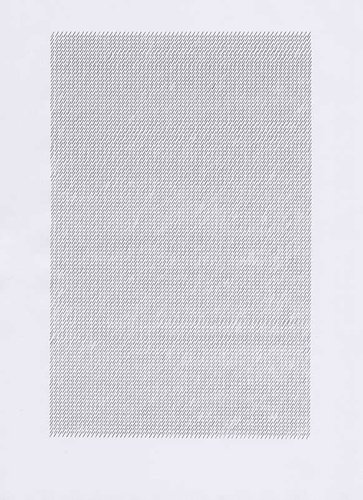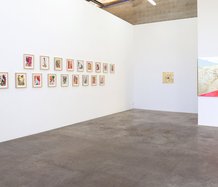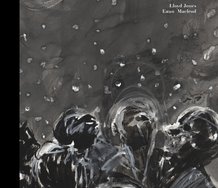Andrew Paul Wood – 11 August, 2020
What it essentially boils down to is one of the inherent qualities of minimalism; when you make work with the same tools and materials in a similar way, inevitably you're going to get similarities. This is compounded when you're trying to reduce something to a basic geometric simplicity. Artists have been struggling with that ever since the days they were copying the same classical statues.
EyeContact Essay #39
The Parkin Drawing Prize inevitably gets the public’s jimmies in a rustle. This is understandable given that at $25,000 it’s one of New Zealand’s most lucrative awards, and taste is subjective. When Charlotte Davy—Head Curator of Art at Te Papa—in her capacity as final judge (full disclosure, I was one of the selectors) awarded Poppy Lekner the top award for her Forward Slash I was expecting the usual grunts and moans about it not being drawing.
The work consists of a dense rectangular grid of forward slashes created on a Brother manual typewriter. I long ago resigned myself to the idea that drawing can be conceptual and reduced to any number of variations and meta-variations of Kandinsky’s point and line to plane even if I was resistant to Kirsty Lillico’s carpet-based piece winning in 2017 because at some point you have to draw the line (pardon the pun) with installation. It’s fair to say I ain’t bovvered.
What I wasn’t expecting was Auckland artist Alan MacDonald’s accusation that the work plagiarised a work of the same name by Joel Swanson, and another unnamed person raised concerns that it was similar to Maurizio Nannucci‘s 1964 concrete poem Dattilograme Typwriter Poem.
To my mind, the fact that there is more than one similar work just underlines that it isn’t plagiarism, not least because fundamentally the line spacing is quite different, resulting in a different optical effect to Swanson’s work, and the intent is obviously quite different to Nannucci’s — ie. optical and schematic rather than ascemic or literary.
What it essentially boils down to is one of the inherent qualities of minimalism; when you make work with the same tools and materials in a similar way, inevitably you’re going to get similarities. This is compounded when you’re trying to reduce something to a basic geometric simplicity. Artists have been struggling with that ever since the days they were copying the same classical statues.
Were Theo van Doesburg and Mondrian plagiarising each other? No. Were Donald Judd and IKEA? Of course not. Would we be having this conversation about say, for example, makers of tapa and tuvaevae who use similar traditional Samoan motifs in similar grid patterns? That would be ridiculous.
The same can be said of artists who use mass-produced readymades. Duchamp wasn’t plagiarising Leonardo when he made L.H.O.O.Q. These issues are simply inescapable when artists are responding to a mass-produced culture like our own, especially when struggling with the contemporary predicament of the Barthesian death of the author/artist. Can you even plagiarise a mechanical process?
At the end of the day such accusations look like little more than sour grapes and mean-spirited bullying by people who should probably know better if they are familiar with such works in the first place. Sometimes you just have to reach a level of self-awareness where you realise that your personal peccadilloes aren’t absolute. At such times I’d rather just enjoy the event and be happy for the winner. It doesn’t matter.
Andrew Paul Wood
Recent Comments
John Hurrell
Here is the catalogue for the show. https://mcusercontent.com/8f82af1219ea401a12c2ff2a4/files/6570001b-cbcb-43ec-a779-d425b1ec3994/Catalogue_web.03.pdf
Andrew Paul Wood
You seem to be putting a lot of words in my mouth, Barry. I do not speak for Charlotte Davy ...
Barry Thomas
Here's the thing. What's the point of art? Is it to perpetually reinvent the wheel? Or is it's purpose to ...

 Two Rooms presents a program of residencies and projects
Two Rooms presents a program of residencies and projects Advertising in this column
Advertising in this column



This Discussion has 4 comments.
Comment
John Hurrell, 2:04 p.m. 11 August, 2020 #
There is an argument that the winning 2020 Parkin Drawing Prize work is a step backwards from say the 2017 Kirsty Lillico work of pieces of carpet--being less innovative--but of course that depends on the range of options presented to judge Davy.
In June 1976 Dom de Clario curated for University of Melbourne's Ewing and George Paton Galleries a radical group show called 'Drawing: Some Definitions', avoiding paper, pencil, ink, and charcoal. And emphasising installation. Predictably it created a huge ruckus.
Barry Thomas, 12:58 p.m. 14 August, 2020 #
Here's the thing.
What's the point of art? Is it to perpetually reinvent the wheel? Or is it's purpose to display new meaning of life? As Duchamp said "art is either plagiarism or revolution"...
Clearly Andrew Paul Wood believes, as one of selectors of this year's Parkin drawing prize long cut works, that art is about hair splitting. Because if he believed that new art has a seminal role in changing the guards of the status quo then neither he nor chief judge Charlotte Davy (chief of our nation's most prestigious cultural Museum Te Papa Tongarewa) had no knowledge of either my own typewriter art (some held in Te Papa's permanent collection), or the Joel Swanson and the 1964 Maurizio Nannucci forward slash works.
If they knew of these earlier works why did they not reference them, in their collective wisdom, when they described the Poppy Lekner work as challenging... et al? Is the work hair splitting plagiarism (ignorance is no excuse for spin doctoring) or genuine revolutionary art (non regionalist parochialism)?
Andrew Paul Wood, Charlotte Davy, Te Papa, the Parkin Prize, the Academy of Fine Art have serious questions to answer.
Andrew Paul Wood, 3:01 p.m. 14 August, 2020 #
You seem to be putting a lot of words in my mouth, Barry.
I do not speak for Charlotte Davy and Charlotte Davy does not speak for me.
I didn't choose the winner, but the whole point of having a different panel and judge every year is because taste is subjective.
Typewriter art has been around as long as typewriters have - why on earth would it be necessary to reference yours or anyone else's work? Not least for the mainstream media.
There is no teleology to art, Barry.
There is very little that can be called revolutionary when the entire history of art can be served up on a platter at the click of a mouse.
Ecclesiastes 1:9. And if you think there's anything remarkable or new about planting cabbages, mate, peasants have been doing that for millennia unaware they were making art.
John Hurrell, 4:30 p.m. 18 August, 2020 #
Here is the catalogue for the show. https://mcusercontent.com/8f82af1219ea401a12c2ff2a4/files/6570001b-cbcb-43ec-a779-d425b1ec3994/Catalogue_web.03.pdf
Participate
Register to Participate.
Sign in
Sign in to an existing account.